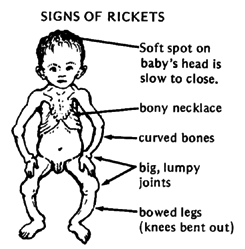thinking RICKETTS?

well, you're WRONG. It's more like R-I-C-K-E-T-S. this:

and this:

Vitamin D is needed in promoting absorption of calcium and phosphorus, from the gastrointestinal tract, which children need to build strong bones. A deficiency of vitamin D makes it difficult to maintain balanced calcium and phosphorus levels in your bones.
The body senses an imbalance of calcium and phosphorus in the bloodstream and hence reacts by taking calcium and phosphorus from the bones to raise blood levels until they are balanced. This softens and weakens the bone structure, resulting most commonly in skeletal deformities such as bowlegs or improper curvature of the spine.
Causes:
- stay indoors too much, or live in climates with little exposure to sunlight. (vitamin D can be produced by the skin when it is exposed to sunlight)
- malabsorption disorders (they reduce the absorption of fats, which will in turn decrease the ability of vitamin D to be absorbed by the body)
- if you follow a strict vegetarian diet
- lack of calcium and phosphorous in diet
- lactose intolerant (have difficulty digesting milk products)
- breastfed without taking vitamin D supplements (breast milk does not supply the needed amount a vitamin D)
- dark skin
- kidney disorders (renal tubular acidosis)
- can't make or use vitamin D because of a medical disorder such as celiac disease
- through genes (hereditary rickets is passed down through families)
By adding more amounts of vitamin D and calcium to the diet would generally correct any bone problems resulting from rickets. However, hereditary rickets require specialised treatment and skeletal deformaties resulting from rickets may need corrective surgery.
No comments:
Post a Comment